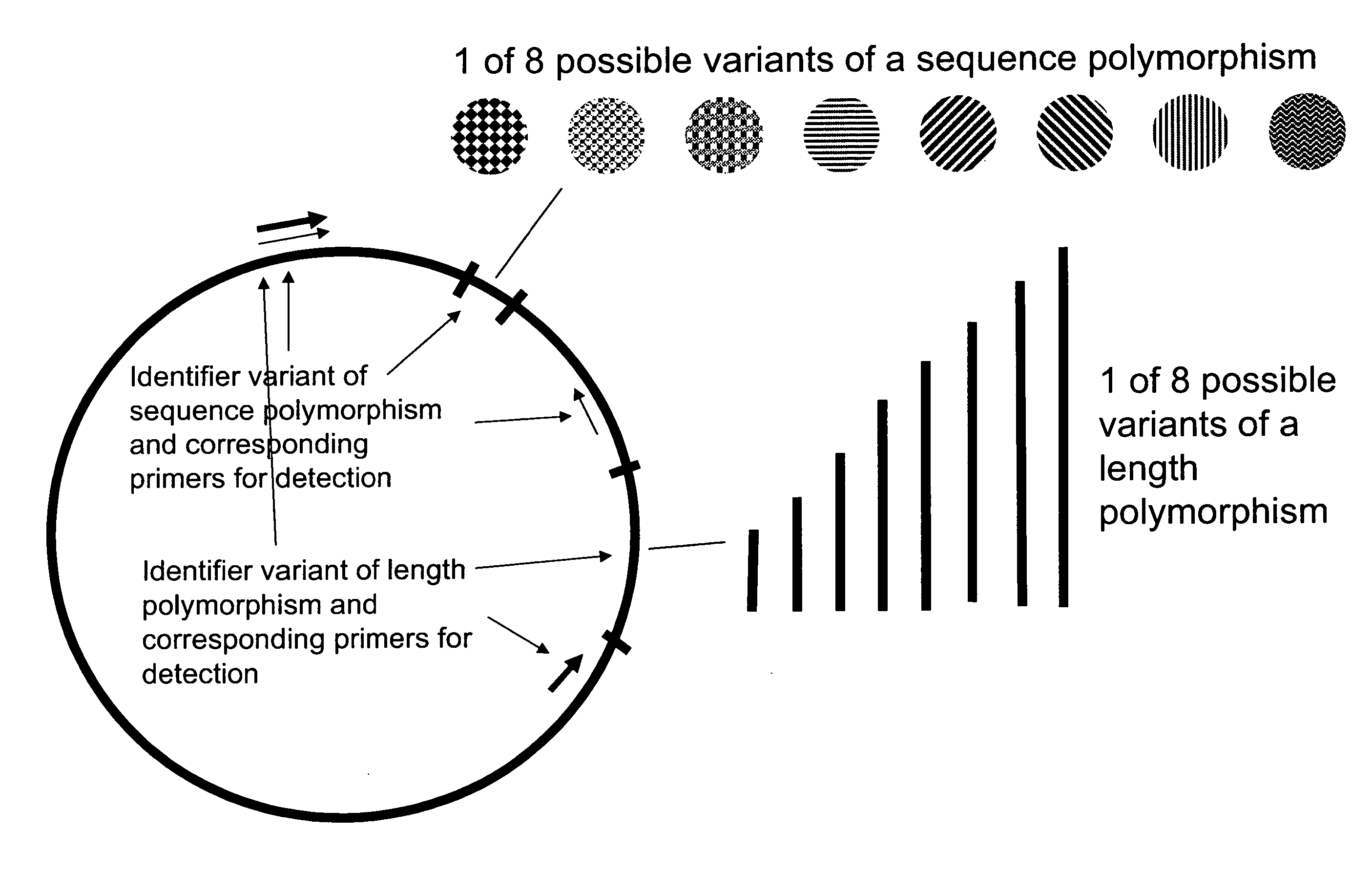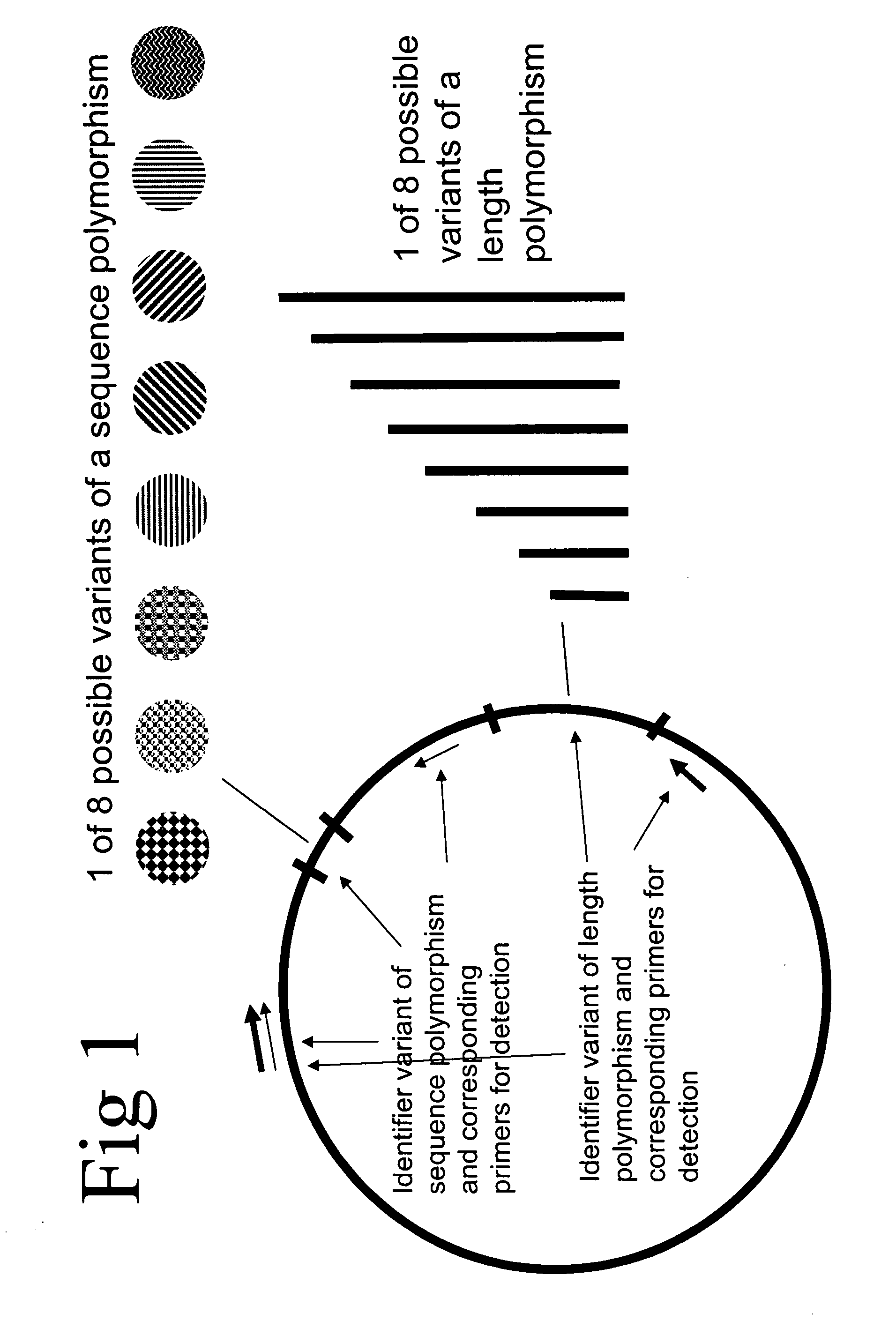Method of identifying a biological sample for methylation analysis
a biological sample and methylation technology, applied in the field of methods of identifying biological samples for methylation analysis, can solve problems such as suppression of expression
- Summary
- Abstract
- Description
- Claims
- Application Information
AI Technical Summary
Benefits of technology
Problems solved by technology
Method used
Image
Examples
example 1
Plant-Specific Fragments for the Identification of Sample Contamination and Sample Confusion During DNA Methylation Analysis
[0465] The Arabidopsis thaliana cellulose syntethase gene (SEQ ID NO: 1) At1g55850 has been checked for sequence homologies with the human genome using a BLAST search (http: / / www.ncbi.nlm.nih.gov / BLAST / Blast.cgi). Primers were designed which allow the amplification of fragments of different lengths by combining primer 1 with primer 2; primer 1 with primer 3; primer 1 with primer 4; primer 1 with primer 5; primer 1 with primer 6; primer 1 with primer 7; primer 1 with primer 8 and primer 1 with primer 9. The Combinations are summarized in Table 2.
TABLE 2Designed plant-specific primerNamesequenceresulting fragment sizeprimer 15′ccgctgcttacttgtcttcc3′SEQ ID NO: 2primer 25′acagcttagccacctcctca3′ 66 bpSEQ ID NO: 3primer 35′ctccggtattcgtcccagt3′122 bpSEQ ID NO: 4primer 45′agcatcccactgtgaaaacc3′167 bpSEQ ID NO: 5primer 55′atggttccatggtttcttcg3′196 bpSEQ ID NO: 6prim...
example 2
Multiplex DNA Methylation Analysis by Usage of Domain Primers with Molecular Identifiers
[0474] Two samples are mixed with cytosine-free primers (200 pmol each) containing a molecular identification domain. Each sample is mixed with a different set of primers.
primer set 1:set1F(SEQ ID NO: 35)5′TGATGGGAGAGTGAGTAGGA3′;set1R(SEQ ID NO: 36)5′TGGAAGATGTTAAGGTTAGGGTCACTTCTAACTCTACCACTTA3′primer set 2:set2F(SEQ ID NO: 37)5′TGATGGGAGAGTGAGTAGGA3′;set2R(SEQ ID NO: 38)5′AGAGTATGGTAAAGTAAGGTTTCACTTCTAACTCTACCACTTA3′
[0475] After bisulfite treatment with the EpiTect kit (Qiagen) samples are amplified as follows: Polymerase Chain Reaction is performed in a total volume of 25 μl containing 5 μl of bisulfite eluate, 1 U Hotstart Taq polymerase (Qiagen), 1× PCR buffer (Qiagen) and 0.2 mmol / l each dNTP (MBI Fermentas). Cycling is done using a Mastercycler (Eppendorf) under the following conditions: 15 min at 95° C. and 45 cycles at 95° C. for 1 min, 55° C. for 45 s and 72° C. for 1:30 min. Amplific...
example 3
Performing a Methylation Detection Workflow Using a Molecular Identification Plasmid as Hybridization Control
[0478] Two molecular identification plasmids (named 23 and 195) were generated. Therefore the two oligonucleotide pairs 23sens (SEQ ID NO: 43) AGTACTTGTATTTGAATTGTTTTTTTTGA / 23anti (SEQ ID NO: 44) CAAAAAAAACAATTCAAATACAAGTACTA and 195sens (SEQ ID NO: 45) AGTACTGTATTTGGTTGGAGTGGGGA / 195anti (SEQ ID NO: 46) CCCCACTCCAACCAAATACAGTACTA were cloned into pGem®-T vector, respectively. The said two oligonucleotide pairs are specific for oligonucleotides of an array tube (see below). Plasmids were isolated from transformed bacteria using a QIAprep Spin Miniprep kit (Qiagen). 500 ng plasmid DNA was linearized at 37° C. in 20 μl water containing 5 U of the restriction enzyme Bfu l and 1×NEB 4 buffer (both New England Biolabs). Reaction was stopped at 80° C. for 20 min. Clones were purified using the PCR-Purification kit (Qiagen). 100 fg plasmid DNA in 5 ng / μl poly-A solution (Roche) in a...
PUM
 Login to View More
Login to View More Abstract
Description
Claims
Application Information
 Login to View More
Login to View More - R&D
- Intellectual Property
- Life Sciences
- Materials
- Tech Scout
- Unparalleled Data Quality
- Higher Quality Content
- 60% Fewer Hallucinations
Browse by: Latest US Patents, China's latest patents, Technical Efficacy Thesaurus, Application Domain, Technology Topic, Popular Technical Reports.
© 2025 PatSnap. All rights reserved.Legal|Privacy policy|Modern Slavery Act Transparency Statement|Sitemap|About US| Contact US: help@patsnap.com



